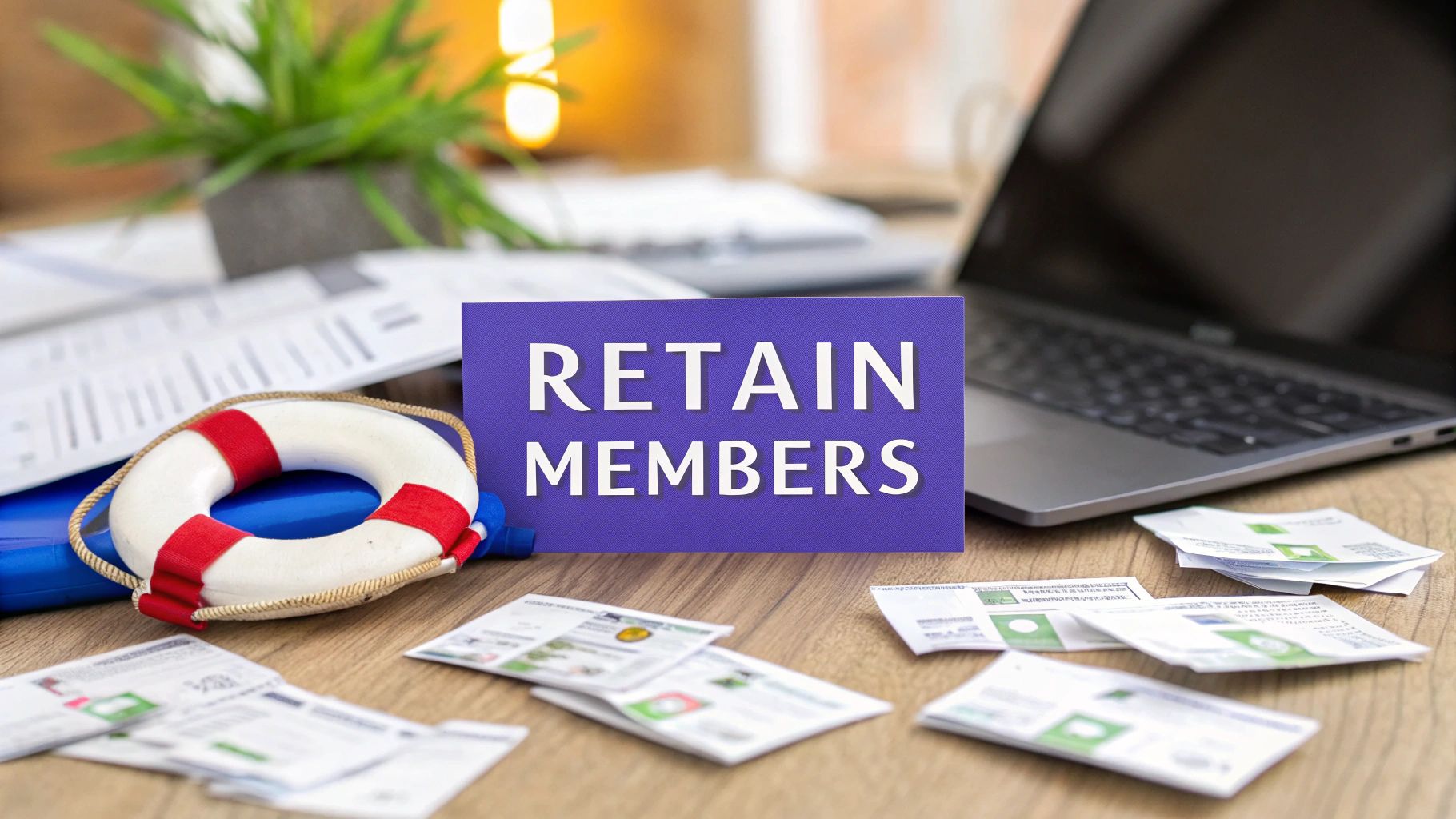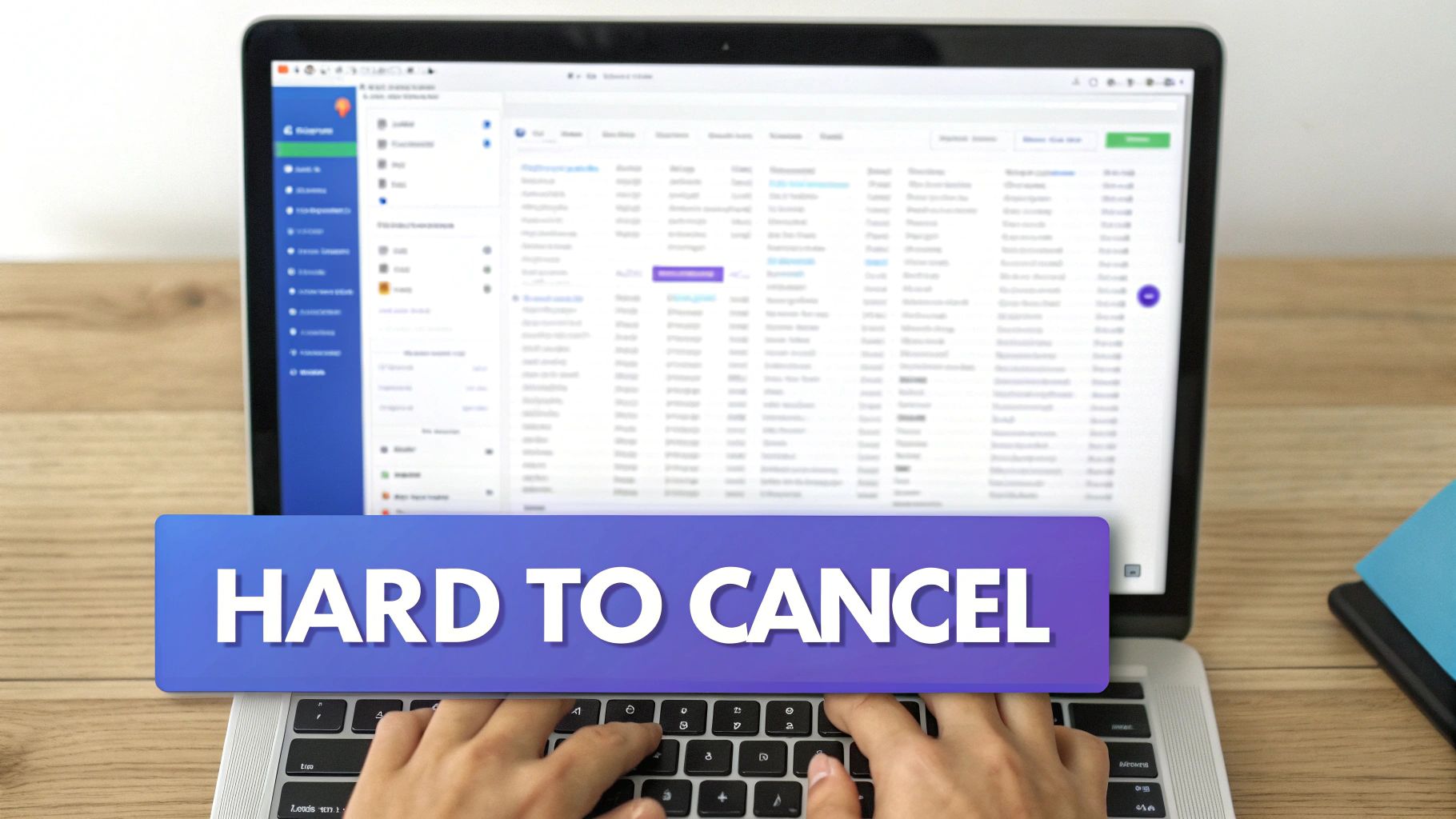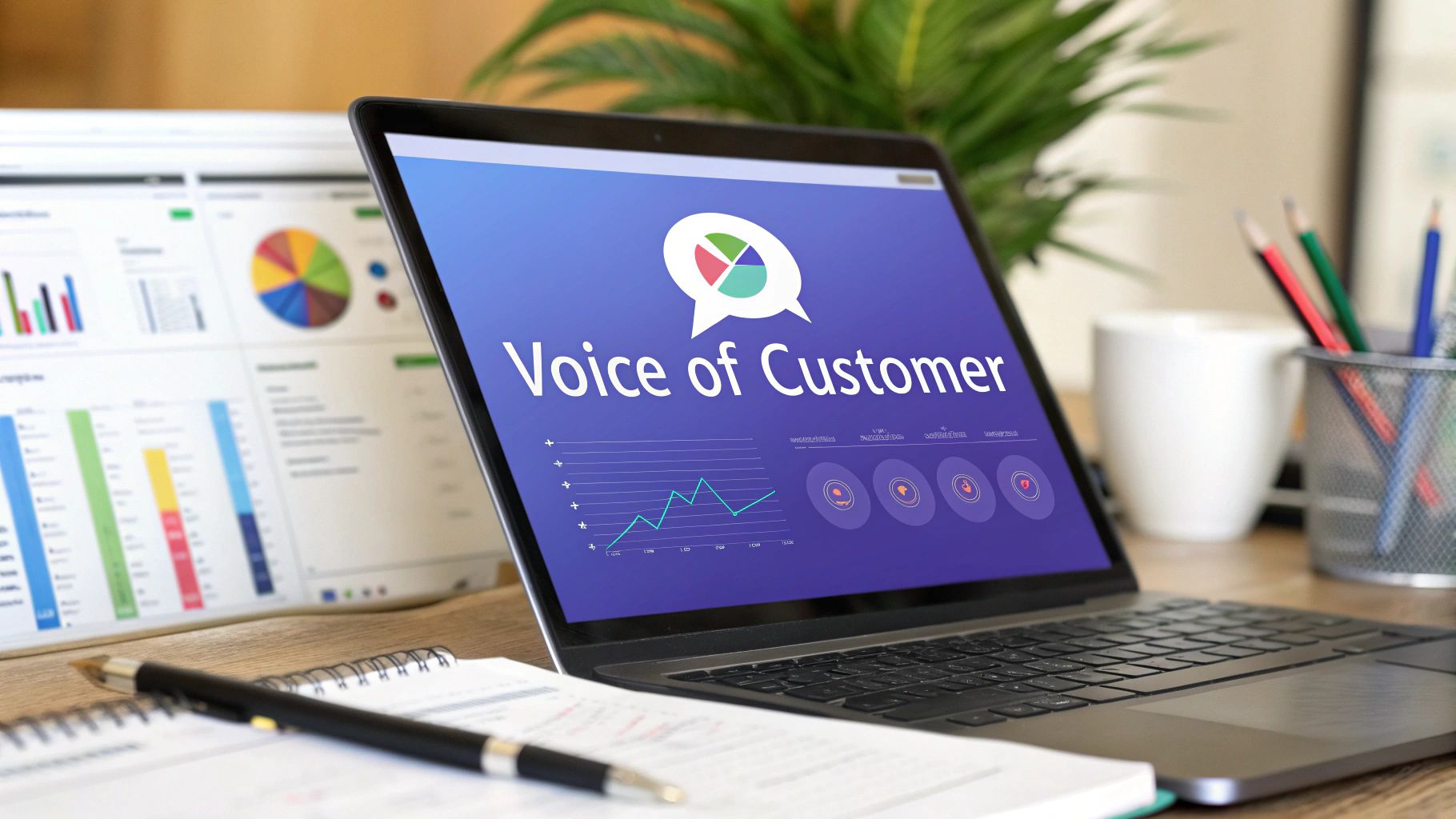Subscription Cancellation Reasons: 7 Ways to Keep Members
Discover subscription cancellation reasons and proven fixes to reduce churn. This guide outlines 7 practical steps to address concerns and boost retention.

Wondering why your subscribers are hitting the 'cancel' button? Knowing the core subscription cancellation reasons is the first step to building a more resilient business. It’s rarely one single issue. Churn is often a mix of factors, from price sensitivity and poor customer service to a simple lack of use. For any recurring revenue business, especially in SaaS, figuring out these patterns is fundamental to long-term growth and stability.
This guide gets straight to the point. We will break down the ten most common reasons customers cancel and provide practical strategies to address each one. You will find actionable steps and clear examples you can use to improve customer retention. We'll look at everything from underutilization and technical glitches to the discovery of better alternatives in the market. Let's get started on turning churn signals into powerful opportunities for improvement.
1. Cost and Price Increases
Price sensitivity is a major factor in customer retention, making cost one of the most common subscription cancellation reasons. Subscribers constantly evaluate if a service provides enough value to justify its price. An unexpected price hike or a gradual increase that pushes the service beyond a customer's budget can easily trigger a cancellation. This is particularly true during economic downturns when both consumers and businesses look closely at their spending.

The market also plays a significant role. When competitors offer a similar product for a lower price, your value proposition weakens. For example, streaming giants like Netflix and Disney+ saw increased churn after announcing price increases, as users re-evaluated their entertainment subscriptions. Similarly, Adobe's Creative Cloud price changes often lead to backlash from its user base, showing that even industry-standard tools are not immune to price sensitivity.
How to Mitigate Price-Related Churn
To combat churn driven by cost, SaaS companies should focus on justifying their price through clear value and strategic communication.
- Communicate Price Changes in Advance: Give users ample notice before a price increase takes effect. Explain the reasoning behind the change, such as new features or improved infrastructure, to show the added value.
- Offer Long-Term Discounts: Encourage loyalty by providing discounts for annual or biennial commitments. This secures revenue and reduces the user's monthly cost perception.
- Provide Tiered Pricing: Segment your customer base with different pricing plans. This allows users to select a tier that fits their budget and feature needs, preventing them from canceling altogether because a single plan is too expensive.
2. Lack of Engagement or Underutilization
When subscribers don't regularly use a service, its value becomes questionable, making lack of engagement a primary subscription cancellation reason. This often happens when users fail to integrate the product into their routine or never discover its key features. If a customer isn't actively using a platform, they are paying for nothing, which makes canceling an easy decision. Initial product adoption is a strong indicator of long-term retention; if a user doesn't find value early on, they are unlikely to stick around.
This pattern is visible across industries. A gym membership is canceled when someone stops going, and a streaming service is dropped if its content library fails to captivate. Similarly, complex software with a steep learning curve often suffers from high churn because users give up before experiencing the "aha!" moment. Without consistent, positive interaction, the subscription's perceived value drops, and churn becomes almost inevitable.
How to Mitigate Engagement-Related Churn
To combat churn from underutilization, SaaS companies must proactively guide users toward value and encourage consistent product usage.
- Prioritize Effective Onboarding: A strong start is important. Develop a guided onboarding process that helps new users achieve a quick win within their first week. This sets a foundation for long-term engagement. To improve your process, explore these powerful customer onboarding strategies on surva.ai.
- Send Personalized Usage Tips: Monitor user behavior to identify underused features. Send targeted emails or in-app messages that recommend features relevant to their specific activities, helping them discover more value.
- Implement Milestone Campaigns: Celebrate user achievements and milestones, such as creating their 10th project or inviting a team member. This positive reinforcement encourages continued use and strengthens their connection to the product.
3. Poor Customer Service or Support Experience
A subscriber's interaction with your support team can make or break their loyalty. A poor customer service experience is a powerful driver of churn, often acting as the final push for a user who is already questioning the value of your service. When customers encounter unresponsive, unhelpful, or difficult-to-access support, their frustration with the product multiplies. In a competitive market, users expect quick and effective solutions through multiple channels like chat, email, and phone.

This factor is a significant reason for subscription cancellations because it directly reflects how much a company values its users. A positive support interaction can turn a frustrated user into a loyal advocate, while a negative one confirms their decision to leave. For instance, Amazon Prime's highly accessible and efficient customer service helps retain subscribers who might otherwise cancel over a delivery issue. On the other hand, a SaaS company with slow email-only support will struggle to keep users who need immediate help with a critical business function.
How to Mitigate Churn from Poor Support
To combat churn related to poor service, businesses should invest in a proactive and user-centric support infrastructure. Implementing effective CRM solutions is a great first step, as they help streamline interactions and personalize support.
- Offer Omnichannel Support: Be available where your customers are. Provide support through live chat, email, phone, and social media to meet different user preferences and urgency levels.
- Invest in Self-Service Resources: Build a comprehensive knowledge base with articles, FAQs, and video tutorials. This lets users find answers instantly, reducing support tickets and improving satisfaction.
- Train and Empower Your Team: Equip your support staff with deep product knowledge and empathy training. Give them the authority to resolve issues without excessive escalation.
- Measure and Improve: Regularly track support metrics like first response time, resolution time, and Customer Satisfaction (CSAT) scores. For a deeper look, explore our guide on how to improve CSAT.
4. Technical Issues or Service Reliability Problems
Reliability is the bedrock of any subscription service. Persistent bugs, crashes, or downtime can quickly erode user trust and become a primary subscription cancellation reason. Customers expect a smooth, uninterrupted experience, and when a service fails to deliver, their frustration mounts. Even brief outages during peak hours or slow performance can be enough to convince them to look for more stable alternatives. This is especially damaging for B2B SaaS, where downtime directly impacts a client's own business operations.
The consequences of unreliability are well-documented. When the trading platform Robinhood experienced major outages during peak trading periods, it led to a mass exodus of angry users. Similarly, the widespread Facebook and Instagram outages in 2021 highlighted how even tech giants are not immune to reliability concerns, causing widespread disruption. For services like Spotify, simple sync failures can degrade the user experience enough to make competitors seem more appealing. These examples show that technical stability is non-negotiable for retention.
How to Mitigate Churn from Technical Issues
To prevent churn caused by poor performance, companies must prioritize stability and transparent communication when issues inevitably arise.
- Maintain a Public Status Page: Create a dedicated status page that transparently communicates uptime, performance metrics, and real-time incident updates. This builds trust and reduces support ticket volume during an outage.
- Implement Robust Monitoring and Alerting: Use comprehensive monitoring tools to detect issues before they impact a large number of users. Set up automated alerts so your engineering team can respond immediately.
- Establish Clear Incident Response Protocols: Develop and practice a clear plan for how your team diagnoses, communicates, and resolves technical problems. This makes for a swift and organized response, minimizing customer impact.
5. Better Alternatives or Competitive Offerings
In a competitive market, subscribers will cancel if a rival product offers superior features, better value, or a more innovative solution. This type of churn is a direct signal of market disruption or a significant product gap. Users rarely switch for a perfectly identical product. They are drawn to clear differentiators like a superior user experience, exclusive content, or unique capabilities that solve their problems more effectively.
This dynamic is common in the SaaS world. For instance, many design teams migrated from Adobe XD to Figma because of Figma's collaborative, browser-first approach. Similarly, Slack saw some enterprise users switch to Microsoft Teams due to its deep integration within the Microsoft 365 ecosystem, offering a bundled value proposition. These examples show that even market leaders must constantly innovate to avoid becoming one of the most cited subscription cancellation reasons.
How to Mitigate Competition-Driven Churn
To protect your user base from competitive threats, focus on differentiation and deeply understand your market position.
- Conduct Regular Competitive Analysis: Systematically benchmark your product against competitors. Go beyond a simple feature checklist to analyze their user experience, pricing strategy, and customer feedback.
- Use Exit Surveys: When a user cancels, ask specifically which competitor they are moving to and why. This provides direct, actionable intelligence about your product's perceived weaknesses.
- Focus on a Defensible Moat: Instead of just matching features, build unique advantages. These could be network effects, proprietary data, exclusive integrations, or a strong community that competitors cannot easily replicate.
- Highlight Your Differentiators: Create comparison pages and marketing content that clearly articulate why your product is the better choice for your target audience. Don’t just list features; explain how your unique approach delivers more value.
6. Limited or Irrelevant Content or Features
When a subscription’s core offering fails to meet expectations, subscribers are quick to leave. Whether it’s a streaming service with a shallow content library, a software tool missing a key function, or a news source covering irrelevant topics, a perceived lack of value is a powerful driver of churn. This issue is magnified when users feel the content or features are not personalized to their specific needs, making the service feel generic and easily replaceable.
This is one of the more direct subscription cancellation reasons because it hits the fundamental promise of the product. The short-lived streaming service Quibi is a prime example; its limited, mobile-only content library couldn't justify its price point for most users. In contrast, SaaS platforms like Asana and Monday.com compete intensely on feature depth, constantly adding new functionalities to solve more user problems and prevent them from seeking alternatives. A subscription lives or dies by the relevance and quality of its offering.
How to Mitigate Churn from Limited Offerings
To combat this, SaaS companies must align their product roadmap directly with user needs and effectively communicate the value of new additions.
- Implement a Data-Driven Roadmap: Regularly survey users and analyze usage data to identify missing features or content gaps. Use this information to build a transparent product roadmap that shows users you are listening to their feedback.
- Leverage Personalization: Use algorithms to create personalized recommendations and experiences. For example, highlight newly added features that are relevant to a specific user's workflow or suggest content based on their viewing history.
- Communicate New Additions: Actively promote new features and content through in-app notifications, email newsletters, and change logs. Highlighting continuous improvement shows users that their subscription is gaining value over time.
7. Changing Needs or Life Circumstances
Life is dynamic, and as a result, customer needs are rarely static. Subscribers often cancel services because their personal or professional situations have changed, making the subscription no longer relevant. This is one of the most legitimate subscription cancellation reasons, as the product may no longer fit their life stage. These shifts can include graduating from school, changing careers, moving, or a business pivoting its focus.
Unlike churn caused by dissatisfaction, this type is often temporary. For instance, a student may cancel a subscription to professional software like Adobe Creative Cloud upon graduation but might resubscribe once they secure a job in a creative field. Similarly, a freelancer might pause a project management tool during a slow period with the full intention of returning when work picks up. Recognizing the temporary nature of these cancellations is key to winning these customers back later.
How to Mitigate Churn from Life Changes
Addressing churn from life circumstances requires flexibility and a long-term view of the customer relationship. The goal is not to prevent the immediate cancellation but to make re-subscribing an easy choice.
- Implement a 'Pause Subscription' Feature: Offer users the ability to pause their account for a set period, like 3 to 6 months. This keeps their data and settings intact, removing the friction of starting over when they return.
- Offer Flexible Plans: Allow users to easily downgrade to a lower-cost or free tier. This keeps them in your ecosystem, making an upgrade simple when their needs change again.
- Create "Welcome Back" Campaigns: Use exit survey data to identify users who canceled due to temporary life changes. Target them with special "welcome back" offers or discounts a few months later to encourage their return.
8. Difficult Cancellation Process
A complicated or deliberately confusing cancellation process is a significant driver behind subscription cancellations. While some companies introduce friction to prevent churn, this tactic often backfires. It creates frustrated users who are more likely to share their negative experiences publicly, damaging the brand's reputation and deterring potential new customers. This practice is also facing increased regulatory scrutiny, with laws in regions like the EU and California now mandating that canceling a service must be as easy as signing up.

This negative user experience is one of the more damaging subscription cancellation reasons because it erodes trust. For example, legacy brands like AOL became notorious for their hard-to-navigate cancellation funnels that required phone calls and long wait times. In contrast, modern services like Amazon Prime and Apple's App Store subscriptions have moved towards a more user-friendly, one-click cancellation model. A difficult offboarding process not only guarantees the customer will never return but also actively turns them into a detractor.
How to Mitigate Churn from a Difficult Cancellation Process
To avoid frustrating users and burning bridges, SaaS companies should design a transparent and straightforward offboarding experience. This approach respects the customer's decision and leaves the door open for their potential return.
- Offer One-Click Cancellation: Provide a simple, self-service cancellation option directly within the user's account settings. Avoid forcing customers to call support or send an email.
- Present Alternatives: During the cancellation flow, offer alternatives like pausing the subscription, switching to a lower-cost plan, or applying a temporary discount.
- Gather Feedback Gracefully: Use the offboarding process to learn why the customer is leaving. An exit survey can provide valuable insights; for more ideas, check out this guide with an exit survey example.
- Ensure Regulatory Compliance: Stay updated on and adhere to regional laws (like those in the EU and California) that govern subscription cancellations to avoid legal penalties and build customer trust.
9. Free Alternatives or Freemium Options
The availability of powerful free or freemium alternatives presents a significant churn risk. Subscribers often cancel when a free product from a competitor, or even a generous free tier of your own service, satisfies their basic requirements. This is a common subscription cancellation reason for users who are cost-conscious or have limited needs, signaling that the perceived value gap between the free and paid offerings is not wide enough to justify the expense.
This dynamic is visible across the software industry. For instance, Canva’s robust free version puts pressure on other design tools to deliver unique, premium value. Similarly, Notion's comprehensive free plan competes directly with paid productivity apps like Evernote, attracting users who do not need advanced features. In the audio space, the open-source editor Audacity remains a popular free choice, challenging paid platforms to prove their worth. These examples show how a strong free offering can become a primary reason for customers to cancel a paid subscription.
How to Mitigate Churn from Free Alternatives
To reduce cancellations driven by free options, SaaS companies must create a clear and compelling distinction between their free and paid tiers. The goal is to make the upgrade an obvious choice for serious users.
- Create Clear Value Gaps: Design your premium tiers with features that solve significant pain points or unlock major efficiencies unavailable in the free version. The upgrade should feel like a necessary step for growth.
- Implement Smart Usage Quotas: Limit the free tier by placing caps on key metrics like storage, number of projects, or feature uses per month. This allows users to experience the platform's value before hitting a paywall.
- Use the Free Tier for Acquisition: Position your free plan as a powerful customer acquisition engine, not a permanent solution for users. Focus on demonstrating value and creating clear upgrade paths with limited-time offers or incentives.
10. Dissatisfaction with Product Updates or Changes
Product evolution is needed for growth, yet major changes can backfire and become one of the top subscription cancellation reasons. Subscribers develop habits around your product's functionality and interface. A sudden UI redesign, feature removal, or workflow alteration can disrupt their routine and create frustration, leading to immediate churn. When users feel an update has made the product worse or removed a feature they relied on, they will look for alternatives.
This phenomenon is common across the tech world. For example, Basecamp faced significant backlash when it removed certain communication features, as it broke established workflows for many of its loyal customers. Similarly, the dramatic redesign of Windows 8 alienated a large segment of users who preferred the familiar Windows 7 interface. These instances show that even well-intentioned updates can lead to customer loss if they disregard existing user preferences.
How to Mitigate Churn from Product Changes
To innovate without alienating your user base, focus on user-centric communication and strategic implementation.
- Communicate Changes Before Launch: Announce upcoming updates well in advance. Clearly explain the "why" behind the changes, detailing the benefits users will gain.
- Offer Beta Testing: Invite a segment of your users to a closed beta group. This allows you to test potentially unpopular changes and gather valuable feedback before a full rollout.
- Implement Phased Rollouts: Instead of forcing an update on everyone simultaneously, release it to small user groups first. This approach allows you to monitor feedback and make adjustments before it impacts your entire customer base.
- Provide an Opt-Out Option: For significant UI or workflow changes, consider offering a temporary toggle that allows users to switch back to the old version. This gives them time to adapt at their own pace.
Top 10 Subscription Cancellation Reasons Comparison
Turn Cancellation Insights Into Action
Knowing the most common subscription cancellation reasons is the first step. The real growth comes from turning those insights into a concrete action plan. Each cancellation, while disappointing, is a data point showing a crack in your product, pricing, or customer journey. Ignoring these signals is like ignoring a warning light on your car's dashboard. You might get a little further, but a breakdown is inevitable.
This article has detailed ten major reasons for churn, from cost sensitivity and poor engagement to competitive pressures and technical glitches. The common thread is a disconnect between the value a customer expects and the value they perceive. Your job is to close that gap. This is not about winning back every single customer. It's about systematically fixing the underlying issues that cause them to leave in the first place.
From Data Points to Strategic Decisions
The journey from raw feedback to a stronger business model requires a structured approach. Start by categorizing the cancellation reasons you collect. Are most users leaving because of price increases? That points to a potential value-proposition problem or a need for more flexible pricing tiers. Is "lack of engagement" a recurring theme? That signals a weakness in your onboarding process or a failure to demonstrate your product's core value quickly.
Treat every cancellation survey response as a direct consultation with a former user. They are telling you exactly what you need to fix to prevent the next customer from leaving for the same reason.
By segmenting this feedback, you can prioritize fixes that will have the most significant impact. For instance, if 30% of cancellations are due to a missing feature that a competitor offers, that's a clear signal for your product roadmap. If another 20% cite poor customer service, it’s time to invest in support team training or better help desk software. Ultimately, knowing and implementing effective strategies to reduce customer churn is key to retaining your subscriber base and boosting your bottom line.
Your Next Steps: Building a Resilient Subscription Model
The most successful SaaS companies are not the ones that never lose a customer. They are the ones that learn the most from the customers they lose. They build a continuous feedback loop that informs every part of the business, from product development to marketing messaging.
Here are your actionable next steps:
- Implement an Exit Survey: If you do nothing else, do this. Start collecting data on why customers are leaving. Simple, direct questions are often the most effective.
- Analyze the Trends: Don't let the data sit in a spreadsheet. Regularly review cancellation feedback to identify patterns. Share these findings across your product, marketing, and customer success teams.
- Create Proactive Interventions: Use your insights to build solutions. This could mean offering a subscription pause for customers with changing life circumstances or creating better training materials for those struggling with engagement.
Transforming subscription cancellation reasons from a list of problems into a roadmap for improvement is how you build a durable, customer-centric business. It’s a continuous cycle of listening, learning, and adapting that separates high-growth companies from the rest.
Ready to turn churn reasons into retention wins? Surva.ai helps you automatically survey canceling customers, understand the "why" behind their decision, and offer personalized solutions to keep them. Start building a smarter retention strategy today at Surva.ai.


